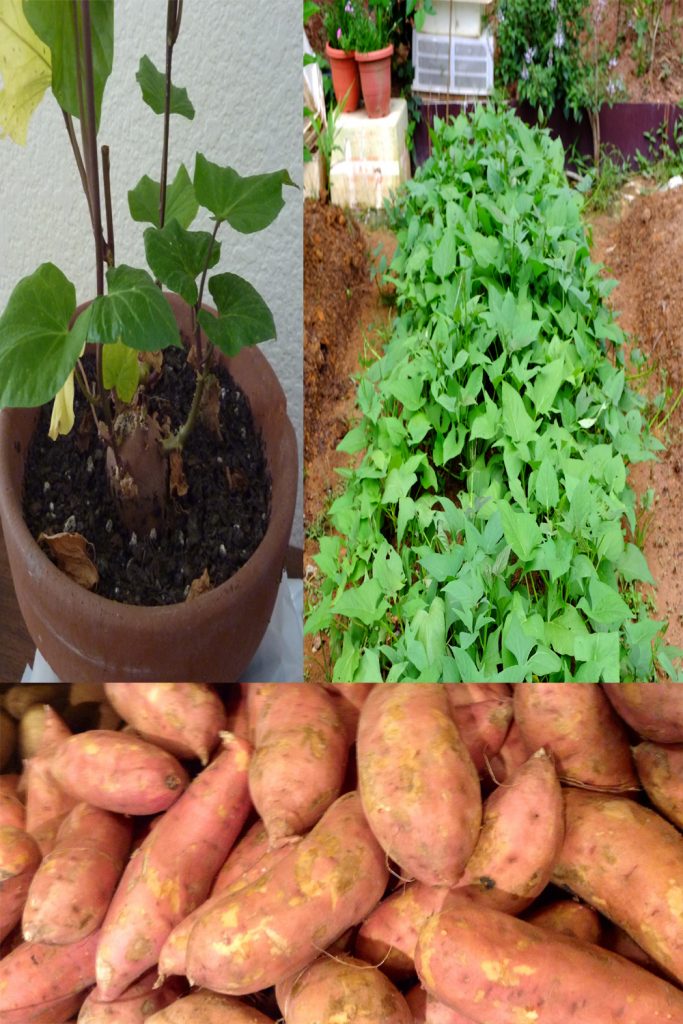Sweet potatoes have nothing to do with ordinary potatoes. Orange-fleshed sweet potatoes are the most well-known, but sweet potatoes can be white, yellow, or even purple. Sweet potatoes grow slowly and are always planted in spring because they require four months of high temperature to develop.
The tuber is fully grown, but it grows surprisingly easily. Because the roots of vines touch the ground, some plants can produce large amounts of crops. There are also various shrubs in the small garden.

How to planting sweet potatoes?
Sweet potatoes can be grown in poor soil but deformed roots are develops in heavy clay or long or stringy in sandy dirt. For producing 8 to 10 pounds of potatoes in a single 10 foot row create a perfect environment of about long , wide,10-inch-high ridges spaced 3 ½ feet apart.
Avoid nitrogen rich fertilizer can produce stunted tubes and lush vines and add plenty of compost to sweet potato field. In north, with the help of black plastics covered the rows of sweet potatoes to keep soil warm and promote strong growth.
It is better to plant root sprouts, known as slips, available in nurseries. Store few roots from your crop for the next year.
Nearly six weeks about to plant sweet potatoes outdoors in your area. Keep the roots in a container with moist sand, saw dust and chopped leaves in a warm spot. Planted sweet potatoes reach 6 to 9 inches long, cut their root. From each slip remove bottom inch and throw away because sometimes that portion harbours disease organisms.
Sweet potatoes extremely frost sensitive and mature in 90 to 170 days. Plant them in full sun after the last frost when the soil has warmed. For planting make the deep hole of 6 inches and 12 inches apart. Conceal all the slips up to top leaves and press the soil down tenderly but firmly and water well.
Also Read: Sweet Potato Farming Information Guide
How to grow sweet potatoes?
If black plastics are not used, for smooth weeds mulch the vines nearly two week after planting, conserve moisture, and for the root development keep the soil loose. Hardly lift longer vines to place them from rooting at the joints, or they put their energy into forming several undersized tubers at rooted area rather than mellowing the main crop at base of the plant. Otherwise, handle plants to prevent wounds that vulnerable disease spores.
In dry weather conditions, maintain 1 inch of water per week until two week before harvest, then the soil dry out little bit. Don’t overwater them, plants can withstand better in dry spell than rainy ones.
How to avoid pests?
Northern gardeners are not more likely encounter pest problems than gardeners in southern area.
Sweet potato weevils with dark blue head and wings puncture stems and tubers to lay eggs. Growing larvae tunnel and feed on the fresh roots and the adults are attacks on leaves and vines. It also spread foot rot with that enlarge brown to black areas on stems near the soil and at the stem extreme. From then weevils multiply quickly then hard to eliminate, use certified virus resistant slips and practice a four year crop rotation. With household trash throw away destroy infected plants and their roots.
Black rots are a fungal disease which results in circular, dark depression on tubers. Dispose the infected potatoes and cure the undamaged roots from the same crop cautiously. Don’t be confused about this disease which creates round, small, dark spots on tuber surface but doesn’t change eating quality and taste.
Reduce the chance of disease by planting healthy slips and avoid dark black spot stem rot by planting resistant cultivator and keep the fresh roots between 55 to 60 degree.
Also Read: How to Grow Organic Potatoes in Your Garden
Harvesting sweet potatoes
Sweet potato tubers can be harvested in about three to four months, depending on the variety; if you prefer to eat the leaves as vegetables, you can eat them in moderation throughout the season; remember to allow enough time to grow plants.
Once the leaves turn yellow, the tubers can be dug out. If the frost hits the leaves, then the tubers are probably fine. Just don’t let them sit on the ground too long after the tips are dry, or they may start to work. Rotting is careful when digging sweet potato tubers near the surface. Their skin is delicate and easily damaged or scratched.
Propagation sweet potatoes
- During winter seasons you can save tubers and plant them in spring with these below steps.
- Before the first frost fall dig up the tubers.
- Store them in a peat, vermiculite or other dry material over the winter.
- Place them in a cool, dry place without light.
- During spring the tubers will start to sprout. Cut them into pieces as each piece has at least one eye.
- After the threat of frost passed away plant them in the garden and maintain the temperature at least 60 degree Fahrenheit.
Don’t interchange sweet potatoes for regular potatoes they two are not related. To get more flavour from these sweet potatoes extend their shelf life, place them in a warm and dry place for about 10 to 15 days before eating.

